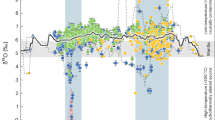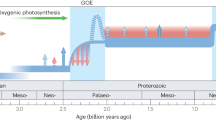Abstract
Fossiliferous lacustrine deposits of middle Pleistocene age have been found in Central Fezzan (Libya)1 on each side of the east–west depressions of the Wadi Shati, south of the Precambrian Qarqaf anticline1–8. They represent the shoreline of a former brackish water lake (Fig. 1) which, some 130,000 yr BP, covered an area about 100km long and 10–20 km wide. At present, the area may be classified as hyperarid. Since 1978, a collaborative study of the fossil assemblages has been undertaken. It included macro- and micropalaeontological determination, Th/U dating, stable isotope and chemical analyses, in parallel with sedimentological and archaeological studies of the sites. Here we consider the Th/U dating and the isotopic palaeohydrology of the lacustrine episode.
This is a preview of subscription content, access via your institution
Access options
Subscribe to this journal
Receive 51 print issues and online access
$199.00 per year
only $3.90 per issue
Buy this article
- Purchase on Springer Link
- Instant access to full article PDF
Prices may be subject to local taxes which are calculated during checkout
Similar content being viewed by others
References
Petit-Maire, N. Rapport Laboratoire Géologic Quaternaire, Marseille (1977).
Petit-Maire, N., Casta, L., Delibrias, G. & Gaven, C. Proc. 2nd Symp. Geology of Libya (1978).
Gaillard, J. & Testud, A. M. Proc. 2nd Symp. Geology of Libya (1978).
Icole, M., Patit-Maire, N. & Riser, J. 8th Réun. a. Sci. Terre, Marseille (Sociéte Géologique Français, Paris, 1980).
Blanc-Vernet, L., Carbonel, P., Gaillard, J., Petit-Maire, N. & Peypouquet, J. P. 8th Réun. a. Sci. Terre, Marseille (Société Gêologique Français, Paris, 1980).
Petit-Maire, N., Delibrias, G., Gaven, C. in Sahara and the Surrounding Seas (eds Sarnthein, M., Seibold, E. & Rogjon, P. ) 289–295 (Balkema, Rotterdam 1980).
Hillaire-Marcel, Cl. Bull. A.S.E.Q.U.A. 56–57, 79–83 (1979).
Petit-Maire, N. et al. Abstr. 26th int. Geol. Congr., 2, 681 1980).
Peypouquet, J. P. thesis, Univ. Bordeaux (1977).
Carbonel, P. & Pinson, J. Proc. 7th int. Symp. on Ostracods 211–217 (Serbian Geological Society, Belgrade, 1979).
Soulié-Märsche, I. I. thesis, Univ. Montpellier (1979).
Soulié-Marsche, I. in The Shati Cardium Lake (ed. Petit-Maire, N. ) (in the press).
Bourrouilh-Le Jan, F. C. r. hebd. Séanc. Acad., Sci., Paris D287, 907–910 (1978).
Degens, E. T., von Herzen, R. P., Wong, H. K., Deuser, W. O. & Jannasch, H. W. Geol. Rdsch. 62, 1–245 (1979).
Cherdyntsev, V. V. Uranium 234 Atomizdat. (IPST, Moscow, 1969).
Rothe, P., Hoefs, J. & Sonne, V. Sedimentology 21, 373–395 (1974).
Shackleton, N. J. & Opdyke, N. D. Geol. Soc. Am. Mem. 145, 449–464 (1975).
Author information
Authors and Affiliations
Rights and permissions
About this article
Cite this article
Gaven, C., Hillaire-Marcel, C. & Petit-Maire, N. A Pleistocene lacustrine episode in southeastern Libya. Nature 290, 131–133 (1981). https://doi.org/10.1038/290131a0
Received:
Accepted:
Issue Date:
DOI: https://doi.org/10.1038/290131a0
This article is cited by
-
A wet climatic terrestrial carbonate record in the middle-upper Pleistocene, north Tunisia
Facies (2021)
-
Three million years of monsoon variability over the northern Sahara
Climate Dynamics (2003)
-
Climate-driven variations in geothermal activity in the northern Kenya rift valley
Nature (1993)
-
Chronology of the major palaeohydrological events in NW Africa during the late Quaternary: PALHYDAF results
Hydrobiologia (1991)
Comments
By submitting a comment you agree to abide by our Terms and Community Guidelines. If you find something abusive or that does not comply with our terms or guidelines please flag it as inappropriate.



